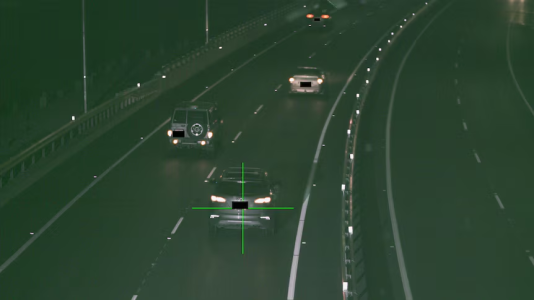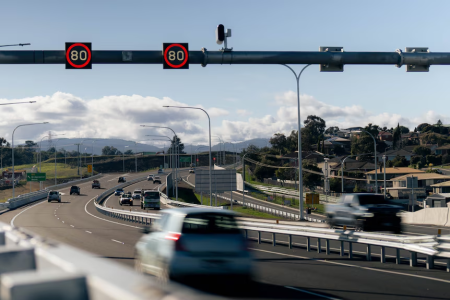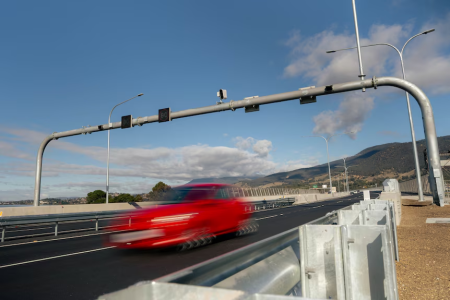Fines to be issued from today after hundreds caught speeding over Bridgewater Bridge
By
ABC News
- Replies 17
Fines will now be issued to people caught speeding over the new Bridgewater Bridge, following a seven-week trial that found an average of 800 drivers per week were caught over the speed limit.
The bridge, one of Tasmania's most expensive infrastructure projects, was opened in June this year.
Since then, the Department of State Growth has been testing and calibrating new speed cameras on the bridge.
A department spokesperson described the results as "completely unacceptable".
The speed limit on the four-lane bridge is 80 kilometres per hour, but the department has determined an average of 800 drivers per week have broken that limit.
The maximum fine for speeding in Tasmania is $1,178 and six demerit points.
Tasmania Police Assistant Commissioner Adrian Bodnar had a blunt message for those caught speeding.
"Speed limits exist for a reason, and anyone who drives above the legal limit is putting themselves and others at serious risk," Assistant Commissioner Bodnar said.
"Please slow down and drive to the conditions so we can prevent any more lives being lost on our roads."
The $786 million Bridgewater Bridge opened to the public on June 1, after more than two-and-a-half years of construction.
The 1.2 kilometre bridge spans the River Derwent and connects suburbs and regions north of Hobart.
Its opening, after years of shifting timelines and increased costs, was welcomed at the time by thousands of excited locals who chose to cross the bridge on foot.
But less than 24 hours after it opened to traffic, police were already investigating reports of reckless driving across the bridge.
"To be honest, you do see a lot of people out there on the roads driving above the speed limit," Mr Tilyard said.
"I think a key issue with that number of 800 a week during the testing is that's 800 people who are above the threshold that police would prosecute.
"Not just people who are over the limit — that's people who are significantly over the limit above that threshold."
Mr Tilyard said speeding was a significant factor in road accidents, with police attributing about 20 per cent of road fatalities in Tasmania to speed-related incidents.
Road deaths have almost doubled in Tasmania compared with last year — 29 people have died on the state's roads so far this year, compared with 15 at the same time in 2024.
There were 31 road deaths in Tasmania last year.
Tasmania does not have any red light cameras in operation, after they were deactivated two decades ago.
Asked if road safety could be improved by reintroducing the cameras, Mr Tilyard said they would improve safety "to some extent".
"There's a lot of intersections and junctions where we see drivers running yellow lights, running red lights," he said.
"We wouldn't be able to afford to have cameras at all of those junctions and intersections, so a key issue is prioritising those points where red [light] cameras will provide the most benefit."
According to the Australian Automobile Association's (AAA) latest report into road safety, released on Tuesday, no state or territory is on track to meet its target of halving fatalities by 2030.
Instead, road deaths have increased by 21.1 per cent since 2021, nationally.
It found Tasmania had the second-highest rate of road deaths per 100,000 people, only behind the Northern Territory.
AAA managing director Michael Bradley said the National Road Safety Strategy was "clearly not working as planned".
"Governments cannot expect to get better results by pursuing the same failed approach," Mr Bradley said.
By Clancy Balen
The bridge, one of Tasmania's most expensive infrastructure projects, was opened in June this year.
Since then, the Department of State Growth has been testing and calibrating new speed cameras on the bridge.
A department spokesperson described the results as "completely unacceptable".
The speed limit on the four-lane bridge is 80 kilometres per hour, but the department has determined an average of 800 drivers per week have broken that limit.
The maximum fine for speeding in Tasmania is $1,178 and six demerit points.
Tasmania Police Assistant Commissioner Adrian Bodnar had a blunt message for those caught speeding.
"Speed limits exist for a reason, and anyone who drives above the legal limit is putting themselves and others at serious risk," Assistant Commissioner Bodnar said.
"Please slow down and drive to the conditions so we can prevent any more lives being lost on our roads."
The $786 million Bridgewater Bridge opened to the public on June 1, after more than two-and-a-half years of construction.
The 1.2 kilometre bridge spans the River Derwent and connects suburbs and regions north of Hobart.
Its opening, after years of shifting timelines and increased costs, was welcomed at the time by thousands of excited locals who chose to cross the bridge on foot.
But less than 24 hours after it opened to traffic, police were already investigating reports of reckless driving across the bridge.
Road safety council boss unsurprised
Speaking to ABC Mornings, Road Safety Advisory Council boss Scott Tilyard said the statistics did not surprise him."To be honest, you do see a lot of people out there on the roads driving above the speed limit," Mr Tilyard said.
"I think a key issue with that number of 800 a week during the testing is that's 800 people who are above the threshold that police would prosecute.
"Not just people who are over the limit — that's people who are significantly over the limit above that threshold."
Mr Tilyard said speeding was a significant factor in road accidents, with police attributing about 20 per cent of road fatalities in Tasmania to speed-related incidents.
Road deaths have almost doubled in Tasmania compared with last year — 29 people have died on the state's roads so far this year, compared with 15 at the same time in 2024.
Tasmania does not have any red light cameras in operation, after they were deactivated two decades ago.
Asked if road safety could be improved by reintroducing the cameras, Mr Tilyard said they would improve safety "to some extent".
"There's a lot of intersections and junctions where we see drivers running yellow lights, running red lights," he said.
"We wouldn't be able to afford to have cameras at all of those junctions and intersections, so a key issue is prioritising those points where red [light] cameras will provide the most benefit."
According to the Australian Automobile Association's (AAA) latest report into road safety, released on Tuesday, no state or territory is on track to meet its target of halving fatalities by 2030.
It found Tasmania had the second-highest rate of road deaths per 100,000 people, only behind the Northern Territory.
AAA managing director Michael Bradley said the National Road Safety Strategy was "clearly not working as planned".
"Governments cannot expect to get better results by pursuing the same failed approach," Mr Bradley said.
By Clancy Balen











